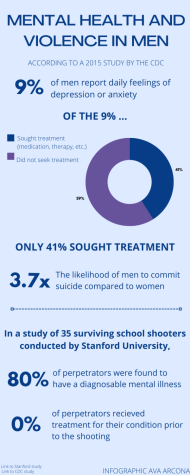Violence prevention isn’t just about guns
School shooting epidemic can be linked to harmful patriarchal values
Staff writer Ava Arcona believes perpetuation of patriarchal ideals is one of the biggest threats to the emotional wellbeing of men and can lead to violence.
June 27, 2022
If I had to guess the leading cause of death in children and teens in our country, guns would not be at the top of my list. Childhood cancer, maybe, or car accidents, but certainly not firearms. Just in the year 2020, 4,368 minors were killed by guns. Living in a state with one of the lowest gun violence rates in the country, it came as a shock to me that guns posed such an enormous threat to people of my age in other regions. But for over 300,000 American students who have witnessed a shooting since the Columbine tragedy, the dangers of gun violence in our country are far too apparent.
The obvious solution to an issue created by the lack of regulation is to implement stricter gun laws, a demand that has been echoed by students and citizens across the country for decades. However, considering the lack of concrete response from lawmakers on the subject, the immense responsibility of protecting America’s students has been put on the shoulders of individual school districts. Parents, students and teachers must now carry the weight of their own community’s safety in the midst of a national crisis.
Despite the bleak circumstances, there are data-supported ways to prevent school shootings by addressing the root of the issue. According to Sandy Hook Promise, 80% of school shooters confided their intentions before executing them, and a staggering 93% planned their attacks in advance. An informed public is essential if we are to be aware of the warning signs and prevent violence in our communities.

Ensuring access to information on this topic should be every districts’ number one priority. Platforms utilized by our district like Say Something promote proactivity in noticing and reporting potential signs of gun violence, while the American Psychological Association provides critical insight into what constitutes as a red flag.
Mental health awareness also plays a key role in identifying and preventing school shootings. This is especially true for young men, given the stigma around men’s emotional wellbeing in our society. The expectation for men to suppress their emotions can be deadly, forcing them to keep their pain bottled up until their breaking point. According to the National Institute of Mental Health, men are 3.7 times more likely to commit suicide than female counterparts and less likely to seek out treatment for their depression.
In order to understand the effects of toxic masculinity in our own schools and homes, the issue must be traced to a larger societal and cultural norm ingrained in American daily life. Men and boys are constantly being told to “man up,” put their emotions on the back burner and act unaffected by anything thrown their way. If no outlet is provided for men to voice feelings of anxiety or depression (which often presents itself in the form of hostility), their conditions will only worsen over time.
That being said, the vast majority of people affected by mental illness (nearly one in five U.S adults, according to the National Institute of Mental Health) will not turn to violence in their lifetime. Not every shooter fits the “loner” profile, and targeting the socially isolated will likely do more harm than good. Being diagnosed with a mental condition also does not justify the use of violence in any way, and it should not be used as rhetoric to defend gunmen. Instead, mental health resources, like the ones available in our district, should be made more accessible nationwide.
Until firearms are restricted on a federal level, we can make a difference in our own communities by encouraging the destigmatization of mental health in a school setting and allowing boys to express their emotions without judgment. Perpetuation of patriarchal ideals is one of the biggest threats to the emotional wellbeing of young men.
It is almost unfathomable that I am writing this at this moment, that we are still fighting the gun violence epidemic after years of hearing “never again” again, and again, and again. Arming teachers is not the answer, nor is accusing the “loner” of conspiracy. ALICE drills are rendered useless if we are uneducated on the causes and warning signs of gun violence. In order to prioritize the safety of the entire school, every student must be accounted for and supported.










